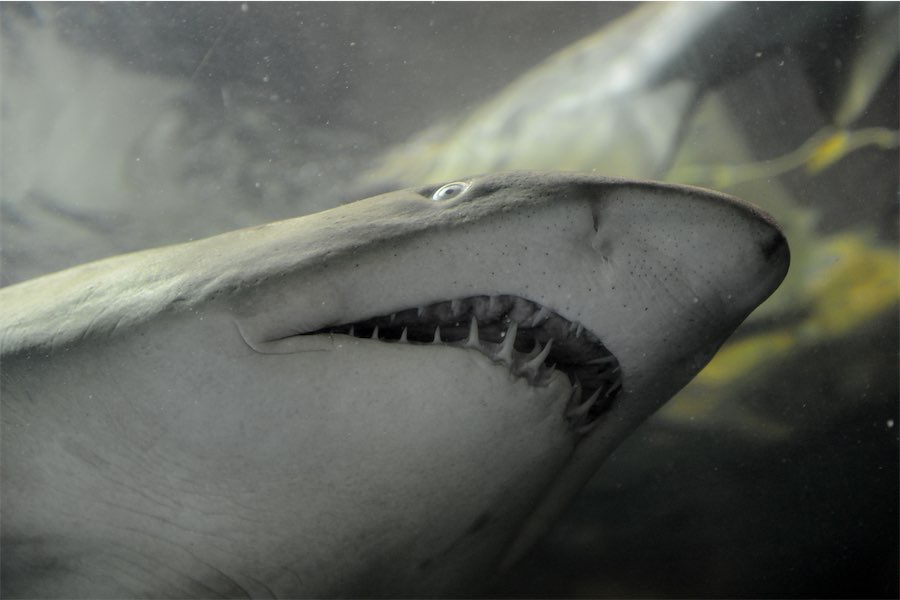
By Katelyn Catanzariti
Sharks adapted their skeletons, teeth and size to become the ultimate fighters of the sea world, surviving all five global mass extinction events over 500 million years.
But that doesn’t mean there really is a megalodon lurking in the depths of the ocean, says John Long, a leading Australian palaeontologist and the author of a new book on sharks.
“That’s bollocks,” he tells AAP, laughing.
“I’ve seen The Meg. It’s absolute fun, but it’s bollocks.”
In the 2018 action movie, The Meg, a 23-metre-long prehistoric megalodon shark thought to be extinct, reappears and attacks deep-sea explorers on the bottom of the Pacific Ocean.
“We haven’t found a single tooth younger than about three million years anywhere on the planet,” says Professor Long, who has been fascinated by the prehistoric sharks ever since he found a fossilised tooth on a beach at the age of eight.
“The other thing is, Meg is like other top apex predators – they mostly feed in the top surface where the whales and other prey are.
“And when they die, guess what? They float. They get washed up on beaches.
“If there was a single population of Megs out there, we would have seen them by now.
“We don’t need to worry about the Meg. The Meg’s not coming back.”
Despite a well-earned reputation as one of the top predators in the ocean, humans don’t even have to worry to much about the sharks alive today.
“More people are killed by deer or by donkeys or horses,” says Prof Long, who has written a book called The Secret History of Sharks: The Rise of the Ocean’s Most Fearsome Predators.
Australians surf in areas that are well known for sharks
Official shark attack records kept by Florida’s Museum of Natural History show about 10 people are killed by a shark a year.
“Admittedly, half of them are from Australia,” Prof Long said.
“But people in Australia like to go surfing in areas that are well known for sharks – they take that risk willingly.”
Prof Long argues everything is a risk.
“I love riding motorbikes. If someone says, ‘oh, you’re crazy, they’re dangerous’, I say no they’re not, they’re fun. That’s the risk you take, you know? You could choke on a chicken sandwich.”
Prof Long has spent decades studying prehistoric fishes, with a particular interest in the sharks that have been a mainstay of the earth’s marine population for half a billion years.
“From a scientific point of view, why they’re really interesting is because of all the jawed animals on the planet today – which include all the fishes, reptiles, amphibians, mammals, etc – they’re the only group that have survived all five of Earth’s major mass extinction events,” he notes.
“And they have reshaped them into successful survivors.”
One of the ways in which sharks have adapted for success is by divesting the bony skeleton they started with and developing more lightweight, flexible cartilage.
It was Prof Long who first discovered the ancient remains that demonstrated this evolutionary step, in the Kimberley region Gogo Formation fossil field in WA.
“We discovered this ancient shark had cartilage with remnant bone cells in it,” he said.
“So it was like a smoking gun showing early sharks had more bone… then they were losing it as they developed these highly advanced kinds of cartilage.
Sharks have honed a series of superpowers
“It was a great scientific discovery at the time… you just want to sing for joy.
“You hit a rock and it splits and you see, not just an amazing fossil, but you see a life of something that once lived – the only evidence of its living presence on the earth … a precious relic.”
Sharks have honed a series of superpowers to survive over the ages, including a fine tuned sensory system – giving them electroreception, an acute sense of smell and incredible hearing – and an unparalleled suite of Swiss Army knife-like teeth, totalling up to 30,000 over a lifetime.
Sharks have also learned to use celestial objects to guide the angle of their attacks and have similar psychological processes to serial killers, according to recent studies.
But it wasn’t always easy, Prof Long says.
Their recovery from The Great Dying extinction event that happened 250 million years ago took a long time.
“They were small for about a hundred million years afterwards – no bigger than about a metre,” he says.
“And it took about another 140 million years after that event before they started getting really big again and becoming top dogs in a sea that was full of gigantic reptiles and other fearsome predators.”
These days, it’s not predators putting sharks at risk. It’s humans.
“(We are) decimating them like faster than you could imagine,” Prof Long says.
Millions killed for their fins for the soup industry
Between 70 million and 100 million sharks are killed each year for their fins for the soup industry – a practice that is increasingly being banned.
Many more are killed as “bycatch”, after being caught in the nets of deep sea fishing trawlers.
Then there’s the sharks killed out of fear.
“Films like Jaws, from the mid 70s on, caused a huge decimation of white shark populations off the North Atlantic,” Prof Long says.
“People were ruthlessly killing them, high on a cocktail of fear and just wanting to get revenge, get them out of the water.
“About 79 per cent of the populations were decimated in the North Atlantic.”
Shark tourism is one way to try to redress the bad wrap the fish get because people will travel far and wide to get up close to a shark, either by scuba diving along smaller varietals or cage diving to see the larger predators.
Prof Long was invited on one of these trips to give a talk on prehistoric sharks and took the opportunity to do his own cage dive.
Over four days he spent up to nine hours in the cage on his own, taking in the “beautiful and magnificent” creatures.
It was nothing like a scene from a movie.
“They’re just powerful, sentient creatures that are swimming around,” he says.
“They’re more interested in the fish and the baits in the water.
“They’re not interested so much in the humans in the cage.”
The Secret History of Sharks: The Rise of the Ocean’s Most Fearsome Predators, by John Long, is out now.
Who can be trusted?
In a world of spin and confusion, there’s never been a more important time to support independent journalism in Canberra.
If you trust our work online and want to enforce the power of independent voices, I invite you to make a small contribution.
Every dollar of support is invested back into our journalism to help keep citynews.com.au strong and free.
Thank you,
Ian Meikle, editor









Leave a Reply